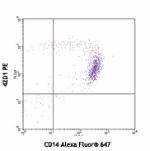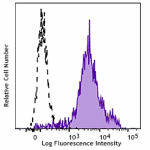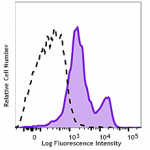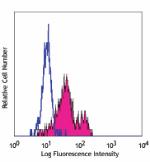- Clone
- 42D1 (See other available formats)
- Regulatory Status
- RUO
- Other Names
- CD85, ILT4, MIR10, Leukocyte Immunoglobulin-Like Receptor subfamily B member 2 (LILRB2), Leukocyte Immunoglobulin-like Receptor 2 (LIR-2)
- Isotype
- Rat IgG2a, κ
- Barcode Sequence
- AACGACGTAGATAGG
- Ave. Rating
- Submit a Review
- Product Citations
- publications
| Cat # | Size | Price | Quantity Check Availability | Save | ||
|---|---|---|---|---|---|---|
| 338717 | 10 µg | £253 | ||||
CD85 is a group of Ig superfamily tansmembrane glycoproteins called Ig-Like Transcripts (ILTs) or Leukocyte Immunoglobulin-like Receptors (LIRs). It is composed of both activating and inhibitory isoforms. The activating subset of ILTs is characterized by containing short cytoplasmic domains and positively charged arginine residues, while the inhibitory isoforms display long cytoplasmic tails containing ITIM motifs. CD85d is a 95kD inhibitory receptor, also known as ILT4, LIR2, or MIR10. ILT4 is expressed on the surface of monocytes/macrophages, and dendritic cells. ILT4 acts as an inhibitory receptor through recruitment of SHP-1 and SHP-2 protein tyrosine phosphatases. The ligands of ILT4 are HLA-A, -B and nonclassical MHC-I molecule HLA-G1.
Product DetailsProduct Details
- Verified Reactivity
- Human
- Antibody Type
- Monoclonal
- Host Species
- Rat
- Formulation
- Phosphate-buffered solution, pH 7.2, containing 0.09% sodium azide and EDTA
- Preparation
- The antibody was purified by chromatography and conjugated with TotalSeq™-D oligomer under optimal conditions.
- Concentration
- 0.5 mg/mL
- Storage & Handling
- The antibody solution should be stored undiluted between 2°C and 8°C. Do not freeze.
- Application
-
PG - Quality tested
- Recommended Usage
-
Each lot of this antibody is quality control tested by immunofluorescent staining with flow cytometric analysis and the oligomer sequence is confirmed by sequencing. TotalSeq™-D antibodies are compatible with Mission Bio’s Tapestri Single-Cell Sequencing Platform for simultaneous detection of DNA and Protein.
To maximize performance, it is strongly recommended that the reagent be titrated for each application, and that you centrifuge the antibody dilution before adding to the cells at 14,000xg at 2 - 8°C for 10 minutes. Carefully pipette out the liquid avoiding the bottom of the tube and add to the cell suspension. For Proteogenomics analysis, the suggested starting amount of this reagent for titration is ≤ 1.0 µg per million cells in 100 µL volume. Refer to the corresponding TotalSeq™ protocol for specific staining instructions.
Buyer is solely responsible for determining whether Buyer has all intellectual property rights that are necessary for Buyer's intended uses of the BioLegend TotalSeq™ products. For example, for any technology platform Buyer uses with TotalSeq™, it is Buyer's sole responsibility to determine whether it has all necessary third party intellectual property rights to use that platform and TotalSeq™ with that platform. - Application Notes
-
Additional reported applications include: negatively modulate myelomonocytic cells signaling. Enhance the binding of HLA-G tetramer to monocytes.
- Additional Product Notes
-
TotalSeq™-D reagents are designed to profile protein expression at single cell level. The Mission Bio Tapestri platform and sequencer (e.g. Illumina analyzers) are required. Please contact technical support for more information, or visit biolegend.com/totalseq/single-cell-dna
The barcode flanking sequences are CGAGATGACTACGCTACTCATGG (PCR handle), and GAGCCGATCTAGTATCTCAGT*C*G (capture sequence). * indicates a phosphorothioated bond, to prevent nuclease degradation.
View more applications data for this product in our Application Technical Notes. -
Application References
(PubMed link indicates BioLegend citation) -
- Colonna M, et al. 1998. J. Immunol. 160:3096
- Allan DS. 1999. J. Exp. Med. 189:1149
- RRID
-
AB_2936585 (BioLegend Cat. No. 338717)
Antigen Details
- Structure
- ILT/LIR family, Ig superfamily, 95kD
- Distribution
-
Monocytes/macrophages, dendritic cells
- Ligand/Receptor
- MHC class I molecules (HLA-A, -B) and nonclassic class I molecule HLA-G1
- Cell Type
- Dendritic cells, Macrophages, Monocytes
- Biology Area
- Immunology
- Molecular Family
- CD Molecules
- Antigen References
-
- Zola H, et al. 2007. Leukocyte and Stromal Cell Molecules: The CD Markers Wiley-Liss A John Wiley & Sons Inc, Publication
- Shiroishi M, et al. 2003. Proc. Natl. Acad. Sci. 100:8856
- Colonna M, et al. 1998. J. Immunol. 160:3096
- Lichterfeld M, et al. 2007. J. Exp. Med. 204:2813
- Gene ID
- 10288 View all products for this Gene ID
- UniProt
- View information about CD85d on UniProt.org
Related Pages & Pathways
Pages
Other Formats
View All CD85d Reagents Request Custom Conjugation| Description | Clone | Applications |
|---|---|---|
| PE anti-human CD85d (ILT4) | 42D1 | FC |
| APC anti-human CD85d (ILT4) | 42D1 | FC |
| PE/Dazzle™ 594 anti-human CD85d (ILT4) | 42D1 | FC |
| PE/Cyanine7 anti-human CD85d (ILT4) | 42D1 | FC |
| Ultra-LEAF™ Purified anti-human CD85d (ILT4) | 42D1 | FC,FA |
| TotalSeq™-B1249 anti-human CD85d (ILT4) | 42D1 | PG |
| TotalSeq™-D1249 anti-human CD85d (ILT4) | 42D1 | PG |
| TotalSeq™-C1249 anti-human CD85d (ILT4) | 42D1 | PG |
| TotalSeq™-A1249 anti-human CD85d (ILT4) | 42D1 | PG |
Compare Data Across All Formats
This data display is provided for general comparisons between formats.
Your actual data may vary due to variations in samples, target cells, instruments and their settings, staining conditions, and other factors.
If you need assistance with selecting the best format contact our expert technical support team.
-
PE anti-human CD85d (ILT4)

Human peripheral blood monocytes stained with 42D1 PE and CD... -
APC anti-human CD85d (ILT4)

Human peripheral blood monocytes were stained with CD85d (cl... -
PE/Dazzle™ 594 anti-human CD85d (ILT4)

Human peripheral blood monocytes were stained with CD85d (IL... -
PE/Cyanine7 anti-human CD85d (ILT4)

Human peripheral blood monocytes were stained with CD85d (IL... -
Ultra-LEAF™ Purified anti-human CD85d (ILT4)

Human peripheral blood monocytes stained with LEAF™ purified... -
TotalSeq™-B1249 anti-human CD85d (ILT4)
-
TotalSeq™-D1249 anti-human CD85d (ILT4)
-
TotalSeq™-C1249 anti-human CD85d (ILT4)
-
TotalSeq™-A1249 anti-human CD85d (ILT4)
 Login / Register
Login / Register 













Follow Us